|
Posted in category "Accountability"
Ed Murphy told me: “J. Edgar Hoover is one of my sisters.”
In 1983, I was shocked to hear Ed insinuate that the late FBI director was gay and liked to dress in women’s clothes. Even among very gossipy gay men, I never heard a breath of rumor that the late FBI director liked guys and was also a transvestite. Similarly, in the 1980s at Dignity/NY, I learned that the ruthless society lawyer, Roy Cohn, had contracted AIDS, not cancer of the liver as he claimed. Ed may have known about Hoover from firsthand stories he heard, and likely had pictures to prove it. I’m not clear if Ed Murphy’s claims are from the time of the “Chickens and the Bulls” blackmail period, or, whether the Mafia had compromising photos of Hoover and his associate director and companion, Clyde Tollson, from years before.
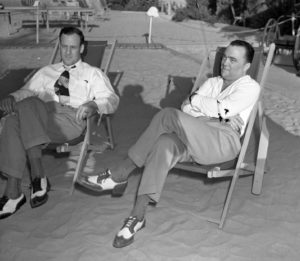 Clyde Tollson and J. Edgar Hoover on vacation In his explosive 1993 book, “Official and Confidential: The Secret Life of J. Edgar Hoover,” author Anthony Summers claimed Hoover denied the existence of the Mafia and never pursued them because the Mafia had blackmail material on him. One of the photos was said to show Hoover blowing Clyde Tollson. The knowledge of Hoover’s homosexual activities may have kept gangsters like Meyer Lansky and Frank Costello safe from FBI scrutiny.
Author David Carter wrote in his 2004 book, “Stonewall: The Riots That Sparked the Gay Revolution,” that when FBI agents joined the “Chickens and the Bulls” case, they found a photograph of J. Edgar Hoover “posing amiably” with one of the ringleaders and discovered information that Clyde Tollson was being blackmailed by the extortion ring. Both the photograph and documents disappeared after the FBI joined the investigation. David Carter thought Ed Murphy was the man posing with Hoover. Journalist and author Burton Hersh said that it was Sherman Kaminsky. It may be that Ed Murphy’s decades of work in Mafia-run gay bars, and his involvement in male prostitution and blackmail gave him access to knowledge and photos, which not only kept him safe from the Feds, but out of jail in the “Chickens and the Bulls” case.
Elwood Hammock, one of the chief extorters in the “Chickens and the Bulls” case also said that J. Edgar Hoover was homosexual as detailed in a memo dated May 19, 1966, from Special Agent in Charge (SAC) in Charlotte, N.C. to Director, FBI. The memo describes a taped telephone interview with an unnamed woman the evening of May 18, 1966. It was conducted by FBI agent Charles S. Miller of Durham, N.C.
“(BLANK) stated that on or about 4-10-66 (BLANK) ELWOOD HAMMOCK (BLANK) New York City. She recalled that ELWOOD was intoxicated at the time, and he was discussing various personalities in whom he and his confederates were interested. During the course of this conversation, he stated to her that J. EDGAR HOOVER was a homosexual. He stated also that he, ELWOOD HAMMOCK, and (BLANK) who she later learned was (BLANK) allegedly had telescopic movies or photos of a blond, blue-eyed young man who resided in either Georgetown or Bethesda, Maryland. It was not clear to (BLANK), but she gathered that this young man was guarded by two Doberman pinscher dogs, and she gathered by inference that this young man was an alleged friend of MR. HOOVER. She stated she was shocked when ELWOOD made such a fantastic allegation, and she informed him that it was utterly impossible and untrue. She stated that (BLANK) was an inveterate liar, and she placed no substance in his statement. She stated she admired the Director greatly, recognized what he had done for the country, and as she thought about the matter more, she decided to repeat ELWOOD’S conversation to a Detective (BLANK) of the New York District Attorney’s staff with whom she had been working.”
The person who had the most damaging information about J. Edgar Hoover was Susan Kaufman Rosenstiel, the 4th wife of liquor magnate Lewis S. Rosenstiel, chairman of Schenley Industries, Inc. Rosenstiel, a bisexual, was a former bootlegger who was a close associate of mobsters Meyer Lansky and Frank Costello. He was good friends with power broker attorney, Roy Cohn, and J. Edgar Hoover. He endowed the J. Edgar Hoover Foundation with $1 million in 1965. Lewis Rosenstiel’s lifelong involvement with mobsters came to light only in 1970, when the New York State Legislative Committee on Crime determined that he was part of a consortium to smuggle liquor during Prohibition.
Lewis and Susan Rosenstiel had an ugly, contentious divorce before Lewis Rosenstiel moved on to Wife #5. Rosenstiel spent almost half a million dollars trying to concoct evidence to use against his wife in divorce proceedings. He may have turned to his friend, J. Edgar Hoover, for help. At least, this is what Susan Kaufman thought, believing that the FBI director helped stack the cards against her in divorce court. In retaliation, she told anyone who would listen that Hoover was a cross-dresser and homosexual.
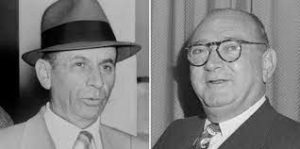 Meyer Lansky & Lewis Rosenstiel During their divorce, Rosenstiel’s 4th wife, Susan Kaufman, alleged that Rosenstiel hosted orgies at the Plaza hotel where he supplied “boy prostitutes” for certain guests. Kaufman would later make the same claims under oath for the New York State Joint Legislative Committee on Crime in the early 1970s. Most of Kaufman’s testimony to the Committee was behind closed doors and remains sealed. Her claims are shocking, but both the Crime Committee Chairman, John Hughes, and his Chief Counsel, Edward McLaughlin, found them credible. McLaughlin remembered her as an excellent witness: “I thought she was absolutely truthful. The woman’s power of recall was phenomenal. Everything she said was checked and double-checked, and everything that was checkable turned out to be true.”
 Roy Cohn on vacation Larry Summer’s book, Official and Confidential: The Secret Life of J. Edgar Hoover,” describes one night in 1958 where Susa n Rosenstiel witnessed a sex scene with her husband, Roy Cohn, J. Edgar Hoover and two teenage boys in a suite at the Plaza Hotel in New York. Hoover was in drag, “wearing a fluffy black dress…lace stockings and high heels, and a black curly wig. He had makeup on, and false eyelashes. Roy introduced him as “Mary” …It was obvious he wasn’t a woman; you could see where he shaved.” They had some drinks, and the teenage prostitutes arrived. They went into the bedroom and “Mary” undressed, taking off his dress and pants and leaving on a garter belt. He lay on the bed, “and the boys work on him with their hands. One of them wore rubber gloves…Then Rosenstiel got into the act with the boys. I thought, “You disgusting old man.” Hoover and Cohn were watching, enjoying it.”
If what she described happened, it would be easy to imagine that Meyer Lansky and others in organized crime had blackmail photos of Hoover in a dress or getting serviced. Susan Rosenstiel quoted her husband as saying, “because of Lansky and those people, we can always get Hoover to help us.” Hoover was a blackmailer himself. “He was the biggest fuckin’ extortionist in the country,”
Ed Murphy told Arthur Bell in a 1978 interview. “He had presidents by the balls. He had a record on everybody and his brother.”Not everybody believed Susan Kaufman’s stories. Robert M. Morgenthau, the U.S. Attorney in New York, found her claims baseless. So did famous attorney William Hundley, at that time working in the U.S. Justice Department. “Susie Rosenstiel had a total axe to grind,” Hundley said. “Somebody who worked for me talked to her. It was made up out of whole cloth. She hated Hoover for some alleged wrong he had done. Plus the story was beyond belief.”
The story does sound fantastical. How could the head of the FBI–and a notorious blackmailer himself–get himself into a position where he was held hostage? Perhaps it was a trade-off. Hoover had his secrets protected and access to male prostitutes. In return, organized crime didn’t need to worry about the FBI nosing too deeply into their operations.
Coming Tomorrow: Chapter 5: Stonewall Shakedowns
The blackmail scheme of “The Chickens and the Bulls” as the New York City Police Department called it, or “Operation Homex” to the FBI, is now unknown or forgotten by most lesbian and gay people and activists. The name refers to an extortion ring of cops and criminals that preyed on prominent, closeted gay men in the 1960s. Corrupt police officials and police impersonators known as “Bulls” used young male prostitutes called “Chickens” to blackmail wealthy, important, or closeted pillars of the establishment across the country. The ring victimized thousands of men, including politicians and government officials, military officers, film, TV and entertainment celebrities and producers, prep school and university professors, headmasters, and trustees, surgeons, scientists, business executives, and Catholic priests. Most of the “chickens” were teenage runaways from homophobic or abusive family backgrounds. They survived by turning tricks in the back of trucks parked on waterfront piers, seedy hotels, or getting pimped out to strangers.
This is how the scam worked: a man would travel to a large city, like New York or Chicago, where he would procure the services of a male prostitute. The prostitute would be solicited at a gay bar, in the bar of a hotel, or in the hotel’s men’s room. Sometimes the Concierge of the hotel was involved. Once the blackmail victim and his prostitute were alone in a hotel room, one of two things would happen; the prostitute would steal the man’s wallet and run out of the hotel, or the “Hotel Detective” would burst into the room and demand cash for not arresting the visiting victim. The stolen wallet would be turned over to the ringleaders, who with their corrupt law enforcement associates, would compile information on the victim. If the “John” was rich, famous or from a prominent family, two members of “law enforcement” would travel to the man’s home or place of business and threaten him with public exposure – even arrest – unless they were given cash to make the case disappear. The men paid rather than have their homosexuality disclosed. One such encounter, heavily redacted, was described in an FBI memo:
“(BLANK) is a guitar player with (BLANK) and while in New York City in 1965 picked up and committed oral copulation on (BLANK) at the Hilton Hotel, 34th Street. Upon (BLANK) return to California, he was approached by an individual named (BLANK)…who posing as a New York City police officers, extorted an unknown sum of money from him. The extortion again was a result of threatened public exposure and/or incarceration for a New York City homosexual act.”
As the NYPD and the FBI pursued their investigations in 1965 and 1966, they found that the blackmail ring operated in large cities around the country and had a fluid cast of about two dozen chickens and bulls. One of them was Edward Murphy, who was the house detective for the Hilton Hotel on 34th Street in New York. “DETECTIVE AT HOTEL IS HELD IN EXTORTION” the August 5, 1965, New York Times headline blared.
“A 39-year-old house detective at the New York Hilton was arrested early yesterday as the leader of a gang that had extorted a total of $100,000 from “rich playboys and executives…The house detective, Edward Murphy, was held in $7,500 bail for a hearing August 13. He was charged with extortion and impersonating an officer.”
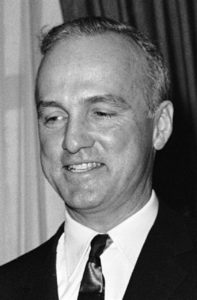 Rep. Peter Frelinghuysen, 1960s Among the men that Ed Murphy identified as victims of the blackmailers were Congressman Peter Frelinghuysen (R-NJ) and Admiral William Church, cousin of the powerful senator Frank Church (D-ID), and head of the New York Naval Yards in Brooklyn. An FBI memo described the night Rep. Frelinghuysen picked up a chicken:
“(BLANK) stated the Congressman was very scared and he told (BLANK) that he was a doctor and that his wife and kids were out of town. The Congressman invited (BLANK) to his house to have a drink. (BLANK) went with the Congressman and after arriving at the house, the Congressman told (BLANK) to take off his clothes and make himself comfortable. (BLANK) undressed and the Congressman undressed. Both had a couple of drinks and the Congressman then committed two perverted sexual acts upon (BLANK).”
Ultimately, Rep. Peter Frelinghuysen paid $50,000 in blackmail money. When Admiral Church was approached by NYPD James McDonnell to testify before a grand jury, he was initially “arrogant and abrupt.” Church told McDonnell that he wouldn’t accompany him back to New York, but he would drive up the next day. Instead, he drove to a motel in Maryland and committed suicide. Admiral Church’s shakedowns had started several months after being robbed of his wallet by a chicken at the Astor Hotel in New York. He had handed over $5,000 to the blackmailers before he put a bullet in his head. Most of the victims were wealthy enough to pay off the blackmailers. In a New York Times article published on March 3, 1966 – “Nationwide Ring Preying on Prominent Deviates,” a celebrity believed to be Liberace is described.
“A TV celebrity, a twinkling star who has millions of female fans all over the world, refused to take the witness stand. However, he did tell investigators that he had paid blackmailers more than $20,000. “I can afford to lose the money,” he said, adding: “I hope they die of cancer.”
The case of the “Chickens and Bulls” began with an arrest of a man impersonating a detective at Grand Central Station in New York. 34-year-old John Aitken was the bogus detective. The arresting officer was NYPD detective James McDonnell. During his interrogation back at the 17th precinct, Aitken said that, in exchange for a light criminal charge, he would reveal details about an extortion ring that had shaken down dozens of prominent closeted homosexuals, most of them married with families. He talked for hours, and McDonnell was amazed at the names he revealed and the money the ring had collected. Aitken’s tips led to the arrest of Ed Murphy by Detective McDonnell at the Hilton Hotel. According to McDonnell, Murphy had been arrested with a counterfeit detective’s shield in his possession. Some of the cops at the station house were ready to take Ed into a back room and give him a beating for passing himself off as one of them. But McDonnell intervened to protect Murphy and recruited him as an informer. “I told Murphy I’d be straight with him and he trusted me.”
The leader of the blackmail ring was 51-year-old Chicago Police detective John J. Pyne. Pyne joined the Chicago Police Department on September 24, 1938, and served until June 24, 1966, when he was arrested by the FBI. The agents found a drawer filled with police badges and identification from almost every state in the country, together with arrest forms and extradition warrants in Pyne’s Chicago home. They also seized an Olympia typewriter from Pyne’s residence whose keys matched various typewritten documents and warrants. He was charged with conspiring to use interstate transportation and the mails to extort money from gay men. According to FBI memos, Pyne was the “big man” who received 10% of all extortion money.
“PYNE is described as a white male American in his 50s, 5’11” and of medium weight, grey hair, of Irish descent, distinguished looking, who drives a 1966 bronze Bonneville and who lived close to O’Hare Field Airport in Chicago, Illinois,” the FBI memo stated. “PYNE is further described as the nephew of former Mayor Kelly of Chicago and as (BLANK) utilized by the gang. PYNE is reverently referred to by gang members as “JAY P.”
Pyne was responsible for seeing that all gang members get out on bond if arrested, securing the services of an attorney for them, furnishing them with authentic and fraudulent police identification credentials and/or warrants. He used his contacts within police departments around the country to get badges and documents that his gang could use in extortion attempts. Pyne was ruthless. According to the FBI memo, when Pyne learned that one or two of his extortionists had had sex with their victims, he contemplated killing those accomplices to keep them quiet.
Sherman Chadwick Kaminsky, 38, Elwood Lee Hammock, 48, and George Michael Gentile, were Pyne’s chief extortionists. Once they were caught, they revealed the full scope of the operation and helped the FBI nail Pyne. Kaminsky went under the alias of Paul Vargo and had “salesman” listed as his occupation. Kaminsky said he was “born and raised on the streets of New York.”
 Sherman Chadwick Kaminksky, 1966 His working partner was 27-year-old John Fellenbaum, a six-foot bodybuilder whose beefcake physique was an attractive lure. In most instances, Fellenbaum beat the victim and stole his wallet or billfold. During his trial, Fellenbaum made a gentlemanly antiques dealer from Maine take the stand and publicly “out” himself, only to plead guilty immediately after the opening trial session. This angered the judge so much he stated: “I have been sentencing people for twenty-seven years and it has been a long time since I have come upon a case that was so revolting as your case. I think you are so steeped in filth that as I read the report I cringed, and my flesh crept as I read the depth of inequity to which you allowed yourself to sink.”
The blackmail ring was first publicly disclosed on February 17, 1966, when 17 suspects were indicted and nine were arrested, including Murphy. Arrested in New York with Ed Murphy was ex-con and ring member William Joseph Burke, 53. Burke also went by the alias of William J. Casey. Burke had a long criminal record, and nine of the arrests were for impersonating a police officer. The FBI memo describing Burke had a curious notation: “BURKE formerly occupied a position of importance in the homosexual ring hierarchy but that lately he himself has turned into a homosexual, has incurred the gang’s disfavor, and is presently relegated to an inferior position therein.” I was surprised to learn that Ed Murphy was closeted during this period of his life, although he had boyfriends and sex with men and youths. He may have stayed closeted to avoid losing status in the gang as Burke did.
Murphy and Burke were also linked with the Admiral Church shakedown and suicide. Church identified police photos of Murphy and Burke as the phony policemen who called on him at his Pentagon office. Church admitted to paying thousands of dollars in blackmail but denied giving the gang members any military secrets.
 Admiral William Church There is some debate on size of Ed’s role in the extortion ring. I think he was an important cog in New York City with his security job in a hotel and contacts with gay bars and prostitution. Murphy later claimed that he joined the ring to work undercover and help the gay community. This may be revisionist history. Records suggest that after he was arrested, he flipped for the NYPD and the FBI to avoid jail. According to Phillip Crawford, Jr., in his book, “The Mafia and the Gays,” “Murphy was a reprehensible predator in this ugly racket, and his partner-in-crime George Gentile had a conviction record as a so-called “fruit hustler” going back to 1937.”
“Only after Murphy was hit with four indictments by the Manhattan DA (District Attorney Frank S. Hogan) and another one by federal prosecutors (Andrew J. Maloney, Robert Morgenthau) did he flip in 1966 to become a cooperating witness to implicate his co-defendants and save his own ass from hard time.” Phillip Crawford, Jr. says according to an FBI debriefing form, among the men “Murphy threatened were an IRS agent, university professor and a Catholic monsignor. Murphy collected $55,000 just from the priest.”
By the end of the investigation in 1967, 30 men had been convicted and imprisoned on charges of extortion and impersonating a police officer. On September 22, 1967, Ed Murphy pleaded guilty for his involvement in the extortion scheme before U.S. District Judge Sidney Sugarman, and on December 13, 1967, was sentenced by U.S. District Judge Constance Baker Motley to five years imprisonment suspended and placed on five years’ probation. Murphy also pleaded guilty to the New York State indictments against him, but he served no jail time. Because of his cooperation his sentence was suspended. Murphy did give evidence against two other main figures in the ring: John J. Pyne and Sherman Chadwick Kaminsky. The information he provided helped to convict them. Pyne went to jail, and Kaminsky became a fugitive until he was caught in Colorado 11 years later. Although prosecutors often had enough evidence to win convictions at trial, they got most of the ringleaders to plead guilty. Many of the victims did not want to testify, and the prosecutors wanted to shield the victims by not putting them on the stand.
The New York Mattachine Society, a “homophile” rights organization, became involved in the investigation as a go-between law enforcement and the victims. Some of their members were lawyers with connections to high places, and the Mattachine Society’s involvement helped the victims feel more protected and less exposed. In their March 1968 newsletter, the New York Mattachine Society asked why Murphy had not been sentenced for his role in the blackmail. They were incredulous that Murphy, with his previous prison record, and his involvement in a blackmail scheme that terrorized thousands of prominent men, could be let off with just a slap on the wrist. No clear answer was ever given, except to say Murphy made a deal to turn state’s evidence.
“My double agent days started in ’66 with the extortion ring,” Ed Murphy told journalist Arthur Bell in 1978. “It was supposed to be a one-shot deal. We locked up 21 guys. They’re all dead now, except for three of them.” It’s clear Ed Murphy became an informant—whether he volunteered or was coerced—and his name disappeared from newspaper coverage soon after the first round of indictments. Of the nine New York Times articles on the investigation published between February 18, 1966, and July 12, 1967, Murphy was only mentioned in the initial February 18, 1966, story. That Ed Murphy was able to slip away unpunished may be due to the value of the information he provided the FBI. It also may be due to the oft-rumored homosexual blackmail photos he was said to possess of legendary FBI director J. Edgar Hoover.
Coming Tomorrow: Chapter 4: Secret Lives: J. Edgar Hoover and Roy Cohn
Chapter 1 – Meeting Ed Murphy
The story of Ed Murphy is fascinating, the way scandal, secrets, and evil are fascinating. It is a story with all the best ingredients—lust, betrayal, corruption, powerful men, redemption, and most of all—irony.
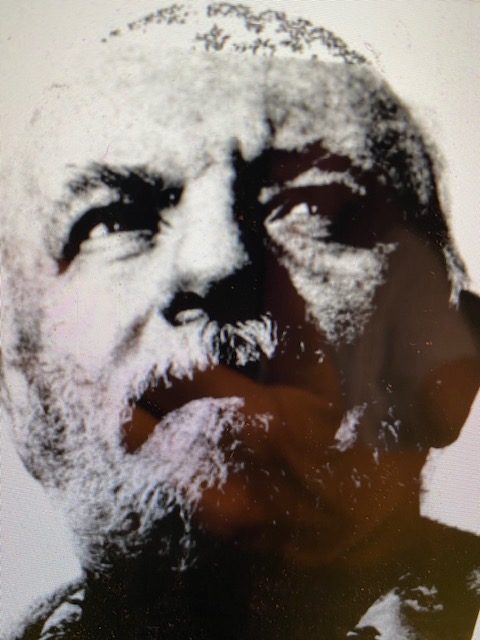 Ed Murphy, 1978 Ed “Skull” Murphy, a gay man who preyed on other gay men, was a secret informer for the FBI. He was protected by the FBI in return for the information he provided on Mafia operations and corruption in New York. He was also rumored to have photos of FBI director J. Edgar Hoover and other prominent government, business and entertainment figures having sex with male prostitutes. Ed Murphy ran prostitution rings of teenage boys and worked as a bouncer in gay bars. He was the doorman at the Stonewall bar the night of the famous raid on June 28, 1969. At that time, he did not identify himself as a gay man. He “came out” a decade later, at the end of the 1970s, when he said that he wanted to quit working for Mafia associates and stop informing for the police and FBI.
Ed reinvented himself as one of the heroes of the Stonewall raid. He continued to work in gay bars. He cultivated a tremendous visibility as the head of the Christopher Street Festival Committee, which organized the vendor booths/party/rally at the end of the annual Gay Pride Parade serving hundreds of thousands of people. Ed Murphy rode in a vintage Cadillac convertible near the head of the parade reserved for those who had been at Stonewall the night of the raid and riots on June 28, 1969. This date is now generally accepted as the beginning of the modern gay and lesbian rights movement.
I met Ed Murphy in the early 1980s when he was working in some bar in the Village, either Stonewall or One Potato, Two Potato. Ed was built like a brick house, stocky and solid, with a body that must have been all muscle in his youth. I was organizing the first group of Conference for Catholic Lesbians (CCL) marchers in New York’s Gay Pride Day parade. We also wanted to have a booth at the Christopher Street Festival in the Village for marchers to hang out after the parade. A booth on Christopher Street would also give us a great opportunity to hand out literature and meet and connect with other lesbians who had been raised Catholic. When I met him, Ed Murphy, or “Mr. Murphy” as I used to call him, was a leader in Heritage of Pride, the organization that ran the parade, festival, and dance in New York City. As such, he was the person to talk to about getting space. Ed always gave CCL table space right in front of St. Veronica’s Church.
“My sister is a nun,” he said to me. “Make sure you take good care of these girls,” he told the guy responsible for assigning spaces.
Our prime location paved the way for many women to find CCL. Ed Murphy always came by our table to make sure that we were fine, and everything was OK. That was my key impression of him: we were small and not influential on the gay scene, but Ed Murphy took care of us. That was also the impression of my friend and CCL co-worker, Barbara M. when she took over organizing the Pride Day booth.
“I remember the last time I had seen him; I was down on Christopher Street and found someone else setting up a booth in our space. I found out that Ed was sitting in a nearby bar, and I went in and found him without any trouble. He seemed to have a lot of adoring fans around him. I told him the story, and he sent out a couple of guys to straighten things out…I thought that they realized Ed was the authority, which prompted them to move, but they may have been afraid of him for all I know…I’d met Ed only three or four times and had short, congenial conversations with him. He was also middle aged by the time I met him. I found him very pleasant. I remember my last conversation with him was his concern that too many of the young fellas were still going bareback, and this was at the height of the AIDS crisis. He said much of the same sort of things I would say today: these kids think they’re immortal; you can’t make them see the seriousness of it because they don’t think it will happen to them. I was never sure if his calling me “Sister” had to do with the fact that I look like a nun or ex-nun…” said Barbara M.
When I met Ed Murphy, I was in my early 30s and he was about the same age as my father. They shared a similar upbringing and formation – the Great Depression and World War II. As boys they were poor, fast with their fists, and nonchalant about thievery. They grew up with no money – they stole to enjoy things their families could never buy. As men they could be gallant or menacing; fiercely protective or brutal. Ed referred to the police by the same name that my father did, “The Bulls.” Big guys with nightsticks that had no hesitancy about using them.
Ed spoke one night to a small group of lesbian and gay Catholics where we met on the Upper West Side in Manhattan. I was very moved to hear the story of his life and description of gay life in New York pre-Stonewall. Ed served time in jail. He stabbed another inmate in self-defense. Ed also made a point to say that he was proud that he didn’t rat people out to “the Bulls.” I had tears in my eyes at the end of his talk. He went through a lot of hell to help bring us to a place where we could live and love more freely. My last memory of him that night was seeing him standing under a streetlight saying goodbye. He looked like an old ex-fighter, scarred, and beaten up, but never a quitter.
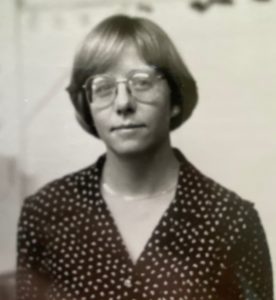 Karen Doherty, 1986 Imagine my shock when, 15 years later, I opened my Wall Street Journal to read an article by William McGowan, “Before Stonewall” which described a vicious extortion ring which targeted prominent and affluent closeted gay men. The gang was finally exposed and put out of business in 1966, but it ran for several years and netted over two million dollars. One of the major figures in this case was Edward “Mother” Murphy, a “ruthless West Side tough” who worked with a dozen other criminals in New York, Chicago, Washington, DC, Los Angeles, San Francisco, and a few other cities to blackmail men who picked up a male prostitute for sex during an out-town trip or when their family was away. “The Chickens and the Bulls,” as the case was known to the New York Police Department and District Attorney’s office, centered on “fairy shaking” or exposing men for their “homosexual proclivities” unless they paid well for it to be kept quiet. Over 1,000 men were victimized by the ring, including the head of the American Medical Association, two Army generals, a Navy admiral, several Hollywood celebrities, college professors and trustees and businessmen.
I relayed my discovery to my friend, Barbara M., who also met Ed Murphy, to hear her reaction. She said,
“To be frank, I’m having a tough time connecting the Ed Murphy I met with the “West Side tough” that he’s described as, or someone who would blackmail fellow gays,” she wrote. “This was in ’65. Ed Murphy was head of security in the Hilton Hotel, and when cornered he cooperated, which is probably why he got the light sentence. Although I think the basic person remains even as the body ages, men mellow. My theory is that the decreased testosterone is a good thing for some of them. Ed may have mellowed a lot and had a metanoia. He struck me as opinioned and forthright, but he didn’t act like a hoodlum. Nonetheless, he might have been. I was just a mere acquaintance; you knew him better. Can you picture that he was involved in this stuff? Maybe prison changed him. His sentence was rather light, and he didn’t serve the entire five years. Maybe he was an informant.”
Many years later, I am still trying to sort out my feelings about Ed Murphy. I knew him as a notable figure in the New York gay community in the 1980s. He was a kind, protective man to the less visible in the city–street kids, drag queens, and mentally challenged children. Ed was generous and caring to all those that he took under his wing, including my group of Catholic lesbians. I am appalled by the image of him as a leader and collaborator in a gay extortion ring, bullying sex and money from vulnerable men and teenagers. Ed Murphy combined prostitution, blackmail and strong-arm tactics into lucrative enterprises that ran for years.
He was also an informer, the worse type of person to anyone of Irish descent. It took the combination of a battery of Irish Catholic New York City Police detectives, the FBI, New York District Attorney Frank S. Hogan, and a federal prosecutor, Andrew J. Maloney, to finally knock him down. But it took the Stonewall raid, a beating by NYC police and a prison rape before he finally had enough and came out as a gay man and activist. That he ended up the Grand Marshall of the New York City Gay Pride Parade 23 years after his conviction for homosexual extortion is a story that boggles the imagination. Catholicism features stories of saints whose lives were full of depravity and evil but ended up redeemed through acts of virtue and heroism. Maybe that is Ed Murphy’s story, or maybe it is just the story he told himself and others.
Chapter 2: “Villainous Skull Murphy” will be posted tomorrow. You can read the whole article Ed_Murphy_Gay_Blackmailer_and_Activitist
 Mosaic at the entrance to St. Michael’s Church In Neil Simon’s 1976 comedy mystery film, Murder by Death, the character Sam Diamond, a parody of the fictional detective, Sam Spade, is played by Peter Falk. His secretary (and girlfriend) blows his cover as a straight, tough guy when she tells the other detectives and guests that Diamond keeps stacks of naked muscle man magazines in his office. Diamond counters that they are part of his detective work –“I’m always looking for suspects!” he says. “I hate them queeries!”
The Rev. George William Rutler, 75, hates queeries, too, but must he have needed new material for an article, Eternal World Television Network (EWTN) program, or one of his pounding homilies. On November 4, 2020, he was caught watching gay porn on the rectory TV by Ashley Gonzalez, 22, a security guard, who filmed a 19-second clip of a man who looks like Father Rutler watching two men blow each other. Gonzalez said she started filming after she heard “sexual noises” on the TV and saw the priest masturbating. Rutler had initially watched election coverage but switched it off around 1:30 am to something more edifying. I think at that point, Joe Biden had beaten Donald Trump for the presidency.
Rev. George William Rutler is one of the most famous conservative priests in the U.S., and a long-time critic of Pope Francis, Democratic politicians and “sodomites.” According to Rod Dreher of the American Conservative, Rutler “presents himself as a flinty arch-conversative who suffers no fools gladly.” He is quite explicit on his view of sex: “The only safe sex is real sex, done for the procreation of life and the sanctification of love.” 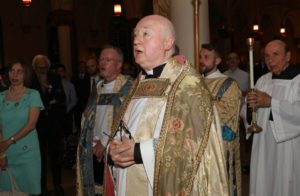
When Gonzalez tried to flee the room, Fr. Rutler grabbed her. “He aggressively threw himself on me and grabbed me sexually, aggressively, and I was fighting him off of me,” Gonzalez told News 12, who added that she sent frantic text messages to her mother begging for help. Gonzalez, who is about five feet tall, got out of the office by elbowing the old geezer in the chest. She made it to the street and called a private detective.
There are a number of weird things in Gonzalez’ story: why would a man who is getting off on two guys having sex try to grope or force himself on a woman? And, how can you possibly have time or your hands free to text your mother if someone is trying to rape or molest you?

What seems unequivocal thanks to a cell phone video clip is that Rev. Rutler’s career as a conservative Catholic spokesman and as a liberal and gay basher is washed up. Even though the assault accusation could be a “he said, she said” situation, the video evidence, and the downloads and browser history on the rectory computer will not lie. Rutler has stepped down as pastor of the Church of Saint Michael Church in Manhattan and has been dropped by EWTN.
One of Fr. Rutler’s quotes on homosexual activity sums up his downfall perfectly: “If people want to engage in aberrant sexual activities, well, by all means then they are free to do so. They are free to pay the penalty.”
P.S. To the Episcopal Church: STOP sending us your self-loathing, hypocritical homosexual priests! We have enough of our own.
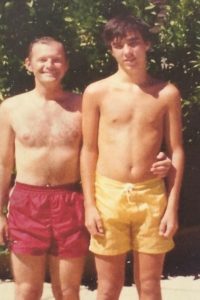
The Report on the Holy See’s Institutional Knowledge and Decision-Making Related to Former Cardinal Theodore Edgar McCarrick (1930-2017) was issued by the Vatican’s Secretariat of State on November 10, 2020. The report was authored by U.S. attorney, Jeffrey Lena, who had previously represented the Vatican in several sex abuse cases. The 449-page document is the result of a two-year investigation, prompted by the public demand by Archbishop Carlo Vigano that Pope Francis resign for his alleged leniency to Cardinal McCarrick. Archbishop Vigano’s “testimony” was released on August 25, 2018 and splashed all over ultra-conservative Catholic media outlets. Gossipy and salacious, he pointed the finger at Pope Francis as the chief villain. Since then, the Vatican had been under heavy pressure to provide an explanation for Cardinal McCarrick’s rise, and his continued influence within the Church after rumors and accusations of sexual activity circulated for several decades.
Before his downfall, Cardinal McCarrick was a star among the U.S. Catholic hierarchy, both for his fund-raising prowess and his sophistication about American and global affairs. He brought the Vatican millions of dollars from the U.S. for papal charities.
Who are the main villains in The McCarrick Report?
#1 – Cardinal Theodore McCarrick. A man who used his position, influence, and financial gifts to manipulate or coerce seminarians and altar servers to have sex with him; and protect him from any career consequences. Many of his victims were children of family friends. All of the seminarians depended on his patronage to be ordained.
#2 – Pope John Paul II (1979-2005) – Pope John Paul II turned a blind eye to clerical sexual activity. His main concerns were freeing Poland from communism, keeping communism out of Latin American, and stamping out North American and European reformers and dissenters. His courtiers had free rein, especially after the mid-1990s when he began to suffer from Parkinson’s Disease, and became increasingly incapacitated mentally and physically. His hubris and handlers kept him propped up in Peter’s Throne so the good times could continue to roll. He ignored numerous complains about McCarrick, and continued to promote him from Bishop of Metuchen, NJ (1981), to Archbishop of Newark, NJ (1986), Archbishop of Washington, DC (2000), and finally named McCarrick a cardinal (2001). The best article I ever read about Pope John Paul II’s culpability in the Church’s sex abuse holocaust is Maureen Dowd’s A Saint, He Ain’t. Poland’s bishops lobbied hard for John Paul II’s early beatification and canonization but were rebuffed in 2019 when they petitioned the Vatican and fellow prelates worldwide to have him elevated still further as a Doctor of the Church and patron saint of Europe.
#3 – Cardinal Stanislaw Dziwisz. The McCarrick Report contains 45 references to Dziwisz, who first met McCarrick while visiting New York with the then, Cardinal Karol Wojtyla in 1976. When Karol Wojtyla became Pope John Paul II in 1978, Dziwisz served as his personal secretary for the Polish pontiff’s entire 27-year reign. Cardinal Dziwisz is accused of covering up sexual abuse in exchange for money. One of McCarrick’s victims, James Grein, said he once accompanied McCarrick on a trip to the Vatican with a briefcase containing envelopes full of money. The envelope addressed to Dziwisz held $10,000. 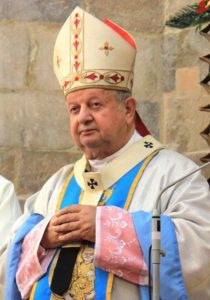
The role of the former papal secretary in stifling sex abuse claims and protecting clerical abusers as favors or for money has come under recent scrutiny in Poland. A 90-minute documentary, “Don Stanislao” was recently shown on TVN24 in Poland. The film aired a long list of accusations about Dziwisz, from covering up for his friends in the seminary to the his role in protecting the late Father Marcial Maciel, the disgraced founder of the Legionaries of Christ, and former Cardinal McCarrick. The documentary also detailed how as archbishop of Krakow he ignored complaints against subsequently convicted local priests.
#4 – Pope Emeritus Benedict XVI – Pope Benedict asked Cardinal McCarrick to step down as archbishop of Washington, DC in 2006. Since he was 76, a year past the age of retirement, the request wasn’t extraordinary. “Over the next two years, Holy See officials wrestled with how to address issues regarding Cardinal McCarrick,” the report’s summary states. “Ultimately, the path of a canonical process to resolve factual issues and possibly prescribe canonical penalties was not taken,” the summary concludes. “Instead, the decision was made to appeal to McCarrick’s conscience and ecclesial spirit by indicating to him that he should maintain a lower profile and minimize travel for the good of the Church.” That didn’t happen; McCarrick continued his global lifestyle and high visibility.
Pope Benedict did and said nothing. Benedict also gave himself the excuse that McCarrick was already retired in not initiating formal disciplinary proceedings. “God’s Rottweiler” as the head of the Congregation for the Doctrine of the Faith (1981-2005) silenced and censored numerous theologians, bishops, priests and religious during his tenure. He decried secularization, liberation theology, feminism, homosexuality, religious pluralism, and bioethics. He gave clerical sex abuse and rape a pass.
#5 – Four New Jersey Bishops. These men vetted Archbishop of Newark McCarrick for the prestigious Washington, DC appointment—Bishop Emeritus Edward Hughes, Metuchen; Bishop John M. Smith, Trenton; Bishop James McHugh, Camden; and Bishop Vincent DePaul Breen, Metuchen. Of the four, only Bishop Edward Hughes advised that it would be “unwise to consider the Archbishop for any promotion or additional honor.” Even so, Bishop Hughes did not pass on reports from seminarians and priests who told him they had been abused by McCarrick. Both James McHugh of Camden and John Smith of Trenton witnessed McCarrick groping a seminarian at a dinner party but never reported it. 
All the New Jersey bishops confirmed the rumor that McCarrick persuaded seminarians to share his bed at his New Jersey Shore house. The Vatican report does not explain by these bishops would not regard sleeping with young men—at minimum–as a serious impropriety and lack of judgement. Nor does it indicate why it didn’t raise a red flag for sexual activity for Vatican officials. The report also included an allegation by an unnamed Metuchen priest who accused McCarrick of having sex with a third priest in June 1987. The accuser was not originally believed since he “had previously abused two teenage boys.”
As expected, The McCarrick Report has plenty of dirt to throw on the legacy of Pope Saint John Paul II: he didn’t bother to investigate sex crimes. That way, he never had sufficient evidence requiring him to act. Because he chose to look the other way, thousands of children, teenagers, seminarians, and vulnerable adults were victimized by clerical predators. The failure of his moral leadership deeply wounded the Catholic Church and many people of faith.
The Report highlights repeated failures in the processing of vetting bishops, a process that often seems more focused on personal connections and ensuring unquestioned adherence to doctrine rather than raising red flags on inappropriate or criminal behavior.
The system in place where archbishops are expected to police abuse by bishops is totally inadequate.
Finally, it shows how certain Vatican prelates—Cardinal Dziwisz and Cardinal Sodano chief among them—were happy to let crime and sin slide if they were paid.
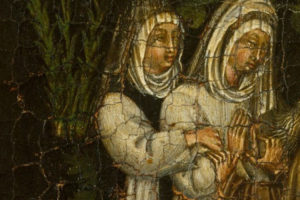
Benedetta Carlini (1590-1661) was a mystic, seductress and nun. Dr. Judith C. Brown chronicled her life in the 1986 book, Immodest Acts. The book came on the heels of Rosemary Curb and Nancy Manahan’s bestseller, Lesbian Nuns: Breaking Silence, which was published in 1985. Benedetta was Abbess of the Convent of the Mother of God in Pescia, Italy when she was accused of heresy and “female sodomy.” Her story is important not only as a documented lesbian relationship in the convent, but how an intelligent, persuasive woman gained, experienced and exercised power and celebrity within Catholicism’ male-dominated structure. In the end, she was brought low by jealousy and her own excesses. She also had miscalculated the tectonic shift in the Church from the Counter Reformation: principally an emphasis on correction of clerical abuses, and more emphasis on intellectual understanding vs. supernatural manifestations of divine favor.
The story of Abbess Benedetta Carlini was discovered by accident by Dr. Brown, a historian at Stanford University while she was researching the economic history of the region and the Medici rule. “I found Benedetta Carlini by chance, by leafing through an inventory of nearly forgotten documents in the State Archive of Florence. The entry in the inventory read: ‘Papers relating to a trial against Sister Benedetta Carlini of Vellano, abbess of the Theatine nuns of Pescia, who pretended to be a mystic, but who was discovered to be a woman of ill repute.’” This discovery of an ecclesiastical investigation contained what is probably the earliest account of a sexual relationship between two nuns. The documents concerning Abbess Benedetta Carlini consisted mostly of transcripts of a series of inquests between 1619 and 1623. 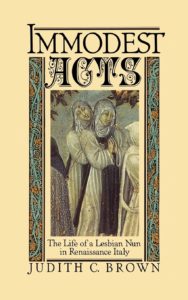
In 1986, Dr. Brown published her book about Benedetta’s life, investigations, and trials. Titled Immodest Acts: The Life of a Lesbian Nun in Renaissance Italy. It was widely reviewed in both scholarly and popular journals and publications. I talked to Dr. Brown about speaking at the Conference for Catholic Lesbians (CCL) West Coast conference in May 1986. Unfortunately, she wasn’t available to participate. Too bad, because many scholars are dry and pedantic, and I found Dr. Brown to be both engaging and knowledgeable. She was one of a handful of women at that time to write an even-handed account of lesbianism who was not a lesbian herself. The book served as a prop in Su Friedrich’s sensational 1987 film, Damned If You Don’t.
Benedetta’s parents brought her to the convent in 1599 when she was nine years old. She entered the Sisters of the Immaculate Conception of the Virgin Mary, more commonly known as the Theatines. The order was founded in 1583 by the Venerable Ursula Benincasa, who was famous for her visions and piety. The fame she gained from her visions led some to accuse her of being possessed by a devil. In 1617, Ursula had her most famous vision, where Jesus (in some versions, Mary) appeared to her. In the vision Jesus praised her order and promised them salvation. Ursula died in 1618 at the age of 71. Benedetta grew up learning about Ursula’s visions and the fame and power that proceeded from them. 
Like the Venerable Ursula, Benedetta had visions. In 1613, when she was 23, she reported visions to the mother superior and her confessor. A young boy helped her climb the “Mountain of Perfection;” she was surrounded by wild animals, only to be saved by Jesus. In another vision, while praying one morning, she found herself “in a garden, surrounded by fruits and flowers.” Male figures came to dominate her visions—a beautiful youth, young men who beat her with sticks, chains, and swords; a handsome guardian angel named Splenditello, and Jesus himself. Over time, the visions increased in intensity and detail, and Benedetta became well known for them. Fearful that Sister Benedetta was being harassed by demonic forces, Sister Bartolomea Crivelli was assigned to share her cell, observe her, and help her if possible.
On the second Friday of Lent 1619, Benedetta received an unmistakable sign of divine favor, the stigmata. Prior to this event Benedetta and others in her community were unsure if her visions were divine or diabolical in origin; but by manifesting the wounds of Christ she proved their divinity.
Her celebrity as a mystic blossomed. That same year the Theatine nuns elected her as their abbess.
Shortly after her election, she began to deliver sermons to the other nuns. She spoke in a trance, an angel speaking through her, exhorting the nuns to purify themselves, and be grateful for Benedetta’s presence in their midst. In the months that followed, there were more trances and visitations: from St. Catherine of Siena and an angel—a beautiful youth in a white robe named Splenditello, even Jesus himself. They spoke from within Benedetta, at times with loving praise, other times harshly or issuing commandments, such as a ban on eating meat, eggs, and dairy products.
On May 20, 1619, Jesus appeared to Benedetta and told her he wanted to marry her in a special ceremony. He had specific ideas for the procession, the chapel decorations, list of guests and the ceremony itself. At the wedding, while the other nuns watched and listened, Benedetta claimed the Blessed Mother looked on benevolently while Jesus placed a gold ring on her finger. Speaking through her, Jesus said, “I would like that this, my bride, be empress of all the nuns.” He added that the Great Duke of Tuscany should be informed of her greatness. All those who did not obey, believe, and cherish her would be punished.
Although the nuns had gone along with Benedetta’s visions, the self-flagellation during trance-sermons and even a ban on salami and cheese; the wedding with Jesus and his dictate that they should obey her or face divine punishment was a step too far. They reported her to the ecclesiastical authorities, who investigated her twice between 1619 and 1623. They discovered that she had faked the stigmata by pricking herself with a needle; secretly ate salami and mortadella during her “ban” on meat and dairy and painted on her miraculous wedding ring with saffron.
But the most damning, was the confession of Sr. Bartolomea Crivelli, Benedetta’s assigned companion. She described her two-year affair with the abbess. The women met for sex at least three times a week. “Embracing her, she would put her under herself and kissing her as if she were a man, she would speak words of love to her. And she would stir so much on top of her that both of them corrupted themselves.” They also masturbated each other and had oral sex to orgasm. Mutual fondling carried a relatively light penalty—two years of penance, plus the loss of Benedetta’s status as abbess. The fact that Benedetta claimed “Splenditello” the angel committed the sexual acts allowed clerical investigators to classify all of Benedetta’s supernatural visions as diabolic in nature. In their report, investigators criticized Benedetta’s “immodest and lascivious language,” and “the great display of vanity” of her mystical marriage with Jesus. 
Benedetta, 36, was condemned to involuntary hermitage and spent the remaining 35 years of her life in solitary confinement. The only other mention of Benedetta is an August 1661 entry in an unnamed nun’s diary stating that Benedetta Carlini died at age 71 of fever and colic pains. The nun added that Benedetta was “always popular among the laity.” For her confession, Sr. Bartolomea Crivelli was spared any punishment. She died in 1660, a year before Benedetta.
Why the long solitary confinement? I suspect jealousy, anger at her duplicity, and fear that her charm and intelligence could help her reclaim a leadership position led some nuns to promote her isolation within the community. She would feel her losses every day. Church authorities wanted to discourage her dangerous popularity with the laity. Her supernatural claims were unwanted in the new age of science and Counter-Reformation.
There is no record of what Benedetta thought and felt after she was led to her lonely cell. Did she have any regrets? Did she revisit her visions– real, imagined or devised? Did her thoughts ever stray to Bartolomea, lying in her bed nearby?
Benedetta Carlini has been the inspiration or subject of films, plays and articles. They include:
Immodest Acts: The Life of a Lesbian Nun in Renaissance Italy by Judith Brown, Oxford University Press, 1986
Damned If You Don’t – a film by Su Friedrich in 1989. If you want to see the film, below are the links for streaming and for DVD
 Damned If You Don’t Vimeo streaming for $3.99
DVD for $24.99
Discourses of Desire: Sexuality and Christian Women’s Visionary Narratives,” by E. Ann Matter, Journal of Homosexuality, 1989-1990
Big Gay Portal to Hell, a podcast by Catherine Clune-Taylor on Caveat
Stigmata, a 2011 play by Carolyn Gage
Vile Affections: Based on the True Story of Benedetta Carlini, a 2006 play by Vanda
Benedetta Carlini: Lesbian Nun of Renaissance Italy, a play by director and playwright, Rosemary Rowe.
Benedetta, an upcoming film directed by Paul Verhoeven and starring Virginia Efira as Benedetta. The film is scheduled to premiere at the 2021 Cannes Film Festival.

“My friends,” he said, “we cannot tolerate or turn a blind eye to racism and exclusion in any form and yet claim to defend the sacredness of every human life.” – Pope Francis, June 3, 2020
That message should sting all those “pro-life” Catholic bishops, priests, prominent lay people and voters who supported Donald Trump for president in 2016.
But it should also sting liberal/progressive educators, union leaders and their apologists. They know education is the biggest ticket out of poverty. Instead, they make excuses for schools that continue to fail their students. They don’t use their considerable political capital to fund school social services, get rid of bad teachers, or change the curriculum to reflect the students they teach.
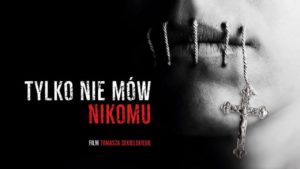
The 2019 Polish documentary on clerical sex abuse, “Tell No One” highlighted a problem: Many of the priestly sex abusers and credibly accused child molesters are well-loved and respected national and local figures. Some people are pushing for a total accounting; others stress individual forgiveness and resumption of public ministry. Notable figures include –
-Father Henryk Janknowski, one of the founders of the Solidarity union. He had his statue removed in Gdansk.
– Father Eugeniusz Makulski, who oversaw the construction of Poland’s biggest basilica. He commissioned a statue of himself offering the building to St. Pope John Paul II. I found his kneeling in front of the pope an apt pose, considering what he is. Makulski’s representations have been removed from the shrine. 
-Father Franciszka Cybula, personal chaplain to anti-Communist hero Lech Walesa. Slawoj Leszek Glodz, Archbishop of Gdansk, lavished praise on Cybula and gave him a grandiose funeral.
– Cardinal Henryk Gulbinowicz, a much-loved figure who helped lead Poland’s anti-Communist movement.
–Archbishop Jozef Wesolowski, former archbishop of Krakow and papal envoy. He was quietly recalled from the Dominican Republic in 2013. Wesolowski was accused of possessing child pornography and paying poor boys and teens for sex acts. Luckily, he died of a “heart attack” before his canonical trial was about to begin. Wesolowski was also wanted on sex abuse charges in Poland. It seemed to me he had quite a good clerical showing at his funeral. 
On August 1, 2019, Archbishop Marek Jedraszewski of Krakow celebrated a Mass commemorating the seventy-fifth anniversary of the outbreak of the 1944 Warsaw Uprising. Archbishop J?draszewski said in his homily: “The red [communist] plague no longer walks on our earth, but a new neo-Marxist one that wants to conquer our souls, hearts, and minds has appeared. It is not a red, but a rainbow plague.”
Did he mean Poland’s pedophile and sex abuser priests, bishops and cardinals; or, was he referring only to Polish LGBT activists?
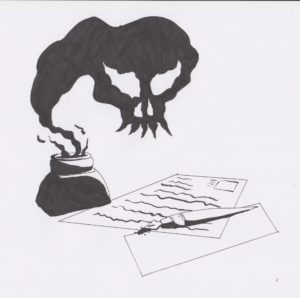
I’m glad I’m not Jeanette DeMelo, editor-in-chief of the National Catholic Register. Today will not be a good day in the office. Vatican correspondent Edward Pentin received a few demerits, too. No holy card prize for best writer this week.
Yesterday, May 7, 2020, the Register published “Appeal for the Church and the World.” Read the letter here. Drafted by Archbishop Carlo Vigano, the letter claimed that the coronavirus pandemic has been exaggerated to foster widespread social panic and undercut freedom, as a preparation for the establishment of a one-world government. It is a religious freedom screed along the lines of “Easter People” – a petition released a month ago by Dr. Janet Smith, ex-Sacred Heart Major Seminary professor.
Vigano’s letter was published by several EWTN-owned media companies, including the National Catholic Register and Catholic News Agency (CNA). Campaign Life Coalition, an ultra-conservative Canadian organization, also published the letter on their website, LifeSiteNews.
Listed right after Archbishop Vigano as a major signatory was Cardinal Robert Sarah, prefect of the Vatican’s Congregation for Divine Worship and the Sacraments. Cardinal Sarah denied signing the letter. “I share on a personal basis some of the questions or concerns raised with regard to restrictions on fundamental freedoms,” he tweeted on his Twitter account, “but I have not signed this petition.”
Bishop Joseph Strickland, the Bishop of Tyler, Texas, told Catholic News Agency in a May 7 email that he “did not sign off on this letter.”
DeMelo said that Archbishop Vigano had vouched for the authenticity of Cardinal Sarah’s signature. “The Register contacted Archbishop Vigano the principal author, and asked him specifically about the authenticity of the signature of Cardinal Sarah and he said: “I can confirm 100% that Cardinal Sarah signed it,” DeMelo told CNA.
Either Archbishop Vigano or Cardinal Sarah are lying. Which one?
It is safe to say the Register won’t be publishing any more letters from Archbishop Vigano and his minions anytime soon without independently verifying every statement and name.

Paul E. Lubienecki, 62, an adjunct professor at Christ the King Seminary in East Aurora, NY was arrested on February 12, 2020, on two felony cyberstalking charges. He faces up to five years in prison if convicted.
Agents from the FBI’s Buffalo, NY field office arrested Lubienecki in connection to a death threat made against 7 Eyewitness News investigative reporter Charlie Specht. Specht has won state and national awards for his investigations of the Diocese of Buffalo. In the last six months Specht and his wife had received over 50 threatening calls from an unknown individual. 
The voicemails began in August 2019, just as the 7 Eyewitness News I-Team reported on scandals at Christ the King Seminary, where multiple seminarians quit the seminary because of alleged abuse and corruption in the diocese. The messages referenced members of Specht’s family and urged Specht to stop his reporting on the diocese. “You’re still a bad Catholic and a horrible reporter,” one voicemail warned. “I hope to God I don’t see you walking around.”
On December 4, 2019, the day Specht reported on Bishop Malone’s resignation he received this message: “Oh, you must be so happy. You destroyed the Diocese of Buffalo and Bishop Malone. Oh, you must be so proud. You’re a piece of shit, you are really a piece of shit… You must be so proud of how you destroyed everything. I’m gonna destroy your career.”
On February 4, 2020, a few hours after the diocese announced the closure of Christ the King Specht gave a live report from the seminary. Moments later, a caller left a voicemail. “You must be so happy the seminary’s closing. You’re a bad person. I know where you live…I’m gonna find you. I’m gonna kill you.”
Lubienecki had nothing to say as he left the courthouse after his arraignment. “Do you have anything to say about the cyberstalking charge?” asked 7 Eyewitness News senior reporter Eileen Buckley. “Why would you make a threat to somebody, especially to kill them. Isn’t that against the teaching of the catholic faith?” questioned Buckley.
Censor Librorum Notes: No wonder the Church is a mess with a dumb-ass like that teaching ethics at a seminary.
|


























